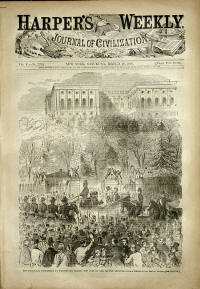Abraham Lincoln Inauguration Picture
![]()
This Site:
Starting a Collection
Top Picks
Online Gallery
Search Page
Order
Winslow Homer
Thomas Nast
Ken Burns Civil War
Up | Winslow Homer: Georgia Delegation | Winslow Homer: Mississippi Delegation | Abraham Lincoln Inauguration Picture | Winslow Homer Civil War New Year | Abraham Lincoln Inauguration | Winslow Homer: Abraham Lincoln Print | General Beauregard Picture | General Thomas | Officer Stringhan | Long Bridge over the Potomac | Civil War Songs | Winslow Homer Bivouac Fire | Winslow Homer New York Fair
Winslow Homer Civil War Art:The Inaugural Procession of President Elect Abraham Lincoln The illustration at right is a Harper's Weekly Cover illustration by Winslow Homer. it is the March 16, 1861 edition of Harper's Weekly. It presents the Inaugural Procession of President Elect Abraham Lincoln. The illustration features Mr. Lincoln in a carriage in front of the United States Capitol grounds. Throngs of people can be seen cheering the newly elected president. This illustration represents the beginning of the transition from Winslow Homer the Lithographer to Winslow Homer the Illustrator. |
March 16, 1861 - The Inauguration of President Abraham Lincoln |
|
In this case, Homer was not simply reproducing a Mathew Brady photograph, but was capturing the event as an eye-witness. The assignment of capturing the inauguration of the president marked a large step forward in Homer's career. It should be realized, however, that the role of an Illustrator is different than the role of an Artist. The illustrator was sent out to capture as accurately as possible to proceedings of the day. The role was not to create or interpret, but to simply record the event, just as a photojournalist would today. In the role of Illustrator, however, you can begin to see many early signs of Winslow Homer the artist. Several style components that would become trademark Homer can be seen in this illustration. First, notice the incredible level of detail, and patience in the image of the capitol in the background. This reflects his work and background as a lithographer . . . but then notice the impatient, almost hurried style found in the image of the person in the lower left side of the crowd. The jacket tone is almost "scratched" in, as if Homer was rushed to finish the image. This impatience becomes a trademark characteristic of many of Homer's war illustrations. Another key Homer style emerges in this image. Notice that the bayonets of all the soldiers are almost perfectly parallel. Every soldier, in every position ends up with his bayonet in the same attitude. This characteristic can be seen in almost all of Homer's civil war illustrations. The bayonets are almost always all perfectly parallel in his work. This pattern tends to bring them out of the picture, and emphasize them. Homer's parallel bayonets create an image of cold hard steel. It is impossible for the viewer to ignore their presence, or their purpose. Its as if the bayonets become the subject of the image. This illustration style becomes more pronounced as the war proceeds, and gives Homer's war illustrations a cold and somber mood. In this illustration, the war had not yet begun, and the bayonets are not as pronounced as they will become in future Homer illustrations, but the style is definitely evident in this image. A Note to our Readers We acquired the images above for the purpose of digitally persevering them on this site for all to enjoy. With the digital archive complete, we are making the original, 140 year old illustrations available for purchase. By selling these original illustrations, we are able to acquire more material to archive on this site. If you are interested in purchasing one of the original Harper's Weekly leafs on this page, contact paul@sonofthesouth.net The leafs are available for a price of $250 a piece, and the proceeds will go to continue to expand the resources on this site. |
|
![]()
|
Email us at: paul@sonofthesouth.net. Copyright © 2003-2018 Son of the South.
|
|
|
|
Are you Scared and Confused? Click Here to read My Snake Story, a story of hope and encouragement, to help you face your fears. |
||
